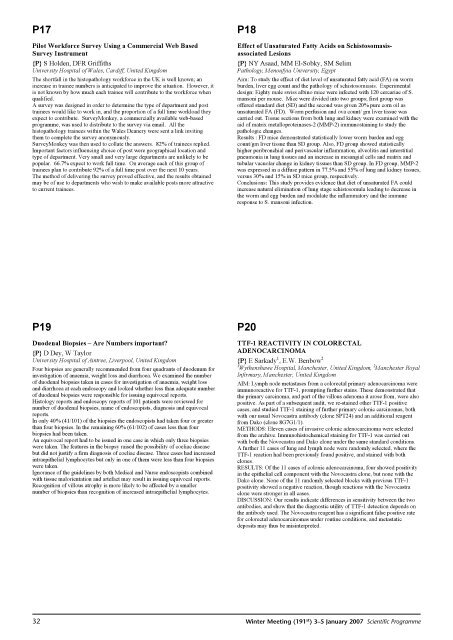2007 Winter Meeting - London - The Pathological Society of Great ...
2007 Winter Meeting - London - The Pathological Society of Great ...
2007 Winter Meeting - London - The Pathological Society of Great ...
- No tags were found...
Create successful ePaper yourself
Turn your PDF publications into a flip-book with our unique Google optimized e-Paper software.
P17Pilot Workforce Survey Using a Commercial Web BasedSurvey Instrument{P} S Holden, DFR GriffithsUniversity Hospital <strong>of</strong> Wales, Cardiff, United Kingdom<strong>The</strong> shortfall in the histopathology workforce in the UK is well known; anincrease in trainee numbers is anticipated to improve the situation. However, itis not known by how much each trainee will contribute to the workforce whenqualified.A survey was designed in order to determine the type <strong>of</strong> department and posttrainees would like to work in, and the proportion <strong>of</strong> a full time workload theyexpect to contribute. SurveyMonkey, a commercially available web-basedprogramme, was used to distribute to the survey via email. All thehistopathology trainees within the Wales Deanery were sent a link invitingthem to complete the survey anonymously.SurveyMonkey was then used to collate the answers. 82% <strong>of</strong> trainees replied.Important factors influencing choice <strong>of</strong> post were geographical location andtype <strong>of</strong> department. Very small and very large departments are unlikely to bepopular. 66.7% expect to work full time. On average each <strong>of</strong> this group <strong>of</strong>trainees plan to contribute 92% <strong>of</strong> a full time post over the next 10 years.<strong>The</strong> method <strong>of</strong> delivering the survey proved effective, and the results obtainedmay be <strong>of</strong> use to departments who wish to make available posts more attractiveto current trainees.P18Effect <strong>of</strong> Unsaturated Fatty Acids on SchistosomasisassociatedLesions{P} NY Asaad, MM El-Sobky, SM SelimPathology, Menoufyia University, EgyptAim: To study the effect <strong>of</strong> diet level <strong>of</strong> unsaturated fatty acid (FA) on wormburden, liver egg count and the pathology <strong>of</strong> schistosomiasis. Experimentaldesign: Eighty male swiss albino mice were infected with 120 cercariae <strong>of</strong> S.mansoni per mouse. Mice were divided into two groups; first group was<strong>of</strong>fered standard diet (SD) and the second was given 20% pure corn oil asunsaturated FA (FD). Worm perfusion and ova count/ gm liver tissue wascarried out. Tissue sections from both lung and kidney were examined with theaid <strong>of</strong> matrix metalloproteinases-2 (MMP-2) immunostaining to study thepathologic changes.Results : FD mice demonstrated statistically lower worm burden and eggcount/gm liver tissue than SD group. Also, FD group showed statisticallyhigher peribronchial and perivascular inflammation, alveolitis and interstitialpneumonia in lung tissues and an increase in mesangial cells and matrix andtubular vacuolar change in kidney tissues than SD group. In FD group, MMP-2was expressed in a diffuse pattern in 77.5% and 55% <strong>of</strong> lung and kidney tissues,versus 30% and 15% in SD mice group, respectively.Conclusions: This study provides evidence that diet <strong>of</strong> unsaturated FA couldincrease natural elimination <strong>of</strong> lung stage schistosomula leading to decrease inthe worm and egg burden and modulate the inflammatory and the immuneresponse to S. mansoni infection.P19Duodenal Biopsies – Are Numbers important?{P} D Dey, W TaylorUniversity Hospital <strong>of</strong> Aintree, Liverpool, United KingdomFour biopsies are generally recommended from four quadrants <strong>of</strong> duodenum forinvestigation <strong>of</strong> anaemia, weight loss and diarrhoea. We examined the number<strong>of</strong> duodenal biopsies taken in cases for investigation <strong>of</strong> anaemia, weight lossand diarrhoea at each endoscopy and looked whether less than adequate number<strong>of</strong> duodenal biopsies were responsible for issuing equivocal reports.Histology reports and endoscopy reports <strong>of</strong> 101 patients were reviewed fornumber <strong>of</strong> duodenal biopsies, name <strong>of</strong> endoscopists, diagnosis and equivocalreports.In only 40% (41/101) <strong>of</strong> the biopsies the endoscopists had taken four or greaterthan four biopsies. In the remaining 60% (61/102) <strong>of</strong> cases less than fourbiopsies had been taken.An equivocal report had to be issued in one case in which only three biopsieswere taken. <strong>The</strong> features in the biopsy raised the possibility <strong>of</strong> coeliac diseasebut did not justify a firm diagnosis <strong>of</strong> coeliac disease. Three cases had increasedintraepithelial lymphocytes but only in one <strong>of</strong> them were less than four biopsieswere taken.Ignorance <strong>of</strong> the guidelines by both Medical and Nurse endoscopists combinedwith tissue malorientation and artefact may result in issuing equivocal reports.Recognition <strong>of</strong> villous atrophy is more likely to be affected by a smallernumber <strong>of</strong> biopsies than recognition <strong>of</strong> increased intraepithelial lymphocytes.P20TTF-1 REACTIVITY IN COLORECTALADENOCARCINOMA{P} E Sarkady 1 , E.W. Benbow 21 Wythenshawe Hospital, Manchester, United Kingdom, 2 Manchester RoyalInfirmary, Manchester, United KingdomAIM: Lymph node metastases from a colorectal primary adenocarcinoma wereimmunoreactive for TTF-1, prompting further stains. <strong>The</strong>se demonstrated thatthe primary carcinoma, and part <strong>of</strong> the villous adenoma it arose from, were alsopositive. As part <strong>of</strong> a subsequent audit, we re-stained other TTF-1 positivecases, and studied TTF-1 staining <strong>of</strong> further primary colonic carcinomas, bothwith our usual Novocastra antibody (clone SPT24) and an additional reagentfrom Dako (clone 8G7G1/1).METHODS: Eleven cases <strong>of</strong> invasive colonic adenocarcinoma were selectedfrom the archive. Immunohistochemical staining for TTF-1 was carried outwith both the Novocastra and Dako clone under the same standard conditions.A further 11 cases <strong>of</strong> lung and lymph node were randomly selected, where theTTF-1 reaction had been previously found positive, and stained with bothclones.RESULTS: Of the 11 cases <strong>of</strong> colonic adenocarcinoma, four showed positivityin the epithelial cell component with the Novocastra clone, but none with theDako clone. None <strong>of</strong> the 11 randomly selected blocks with previous TTF-1positivity showed a negative reaction, though reactions with the Novocastraclone were stronger in all cases.DISCUSSION: Our results indicate differences in sensitivity between the twoantibodies, and show that the diagnostic utility <strong>of</strong> TTF-1 detection depends onthe antibody used. <strong>The</strong> Novocastra reagent has a significant false positive ratefor colorectal adenocarcinomas under routine conditions, and metastaticdeposits may thus be misinterpreted.32 <strong>Winter</strong> <strong>Meeting</strong> (191 st ) 3–5 January <strong>2007</strong> Scientific Programme













